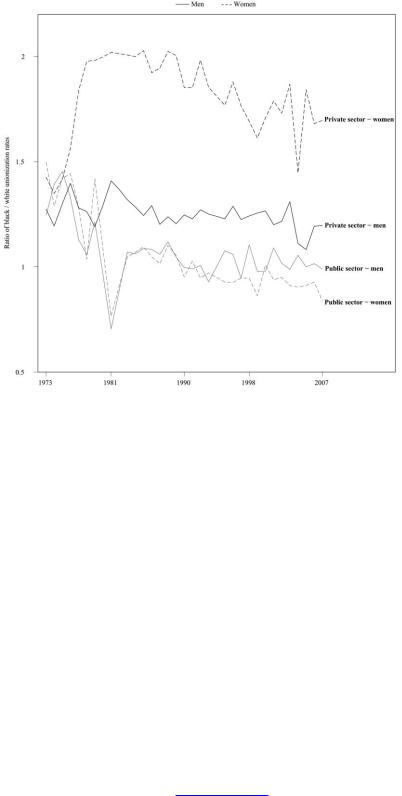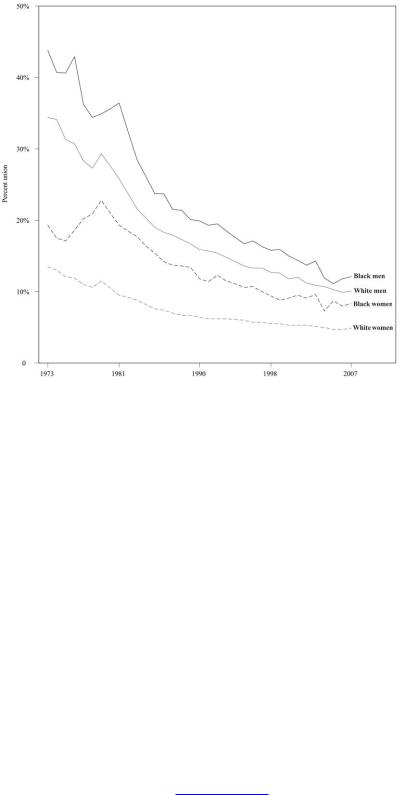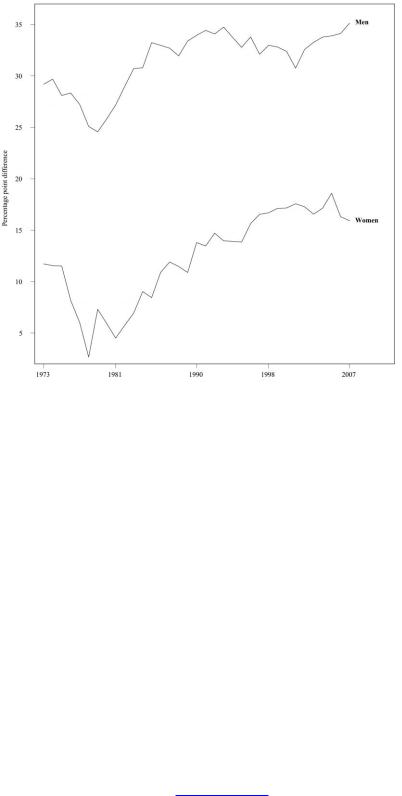
НА_ПЕРЕВОД
.pdf
Organized Labor and Racial Wage Inequality in the United States Author(s): Jake Rosenfeld and Meredith Kleykamp
Source: American Journal of Sociology, Vol. 117, No. 5 (March 2012), pp. 1460-1502 Published by: The University of Chicago Press
Stable URL: http://www.jstor.org/stable/10.1086/663673
Accessed: 12/03/2015 05:23
Your use of the JSTOR archive indicates your acceptance of the Terms & Conditions of Use, available at http://www.jstor.org/page/info/about/policies/terms.jsp
JSTOR is a not-for-profit service that helps scholars, researchers, and students discover, use, and build upon a wide range of content in a trusted digital archive. We use information technology and tools to increase productivity and facilitate new forms of scholarship. For more information about JSTOR, please contact support@jstor.org.
The University of Chicago Press is collaborating with JSTOR to digitize, preserve and extend access to
American Journal of Sociology.
http://www.jstor.org
This content downloaded from 92.242.58.11 on Thu, 12 Mar 2015 05:23:35 AM All use subject to JSTOR Terms and Conditions

Organized Labor and Racial Wage Inequality in the
United States1
Jake Rosenfeld
University of Washington
Meredith Kleykamp
University of Maryland
Why have African-American private-sector unionization rates surpassed those of white workers for decades, and how has privatesector union decline exacerbated black-white wage inequality? Using data from the Current Population Survey (1973–2007), the authors show that African-Americans join unions for protection against discriminatory treatment in nonunion sectors. A modelpredicted wage series also shows that, among women, black-white weekly wage gaps would be between 13% and 30% lower if union representation remained at high levels. The effect of deunionization on racial wage inequality for men is less substantial, but without deunionization, weekly wages for black men would be an estimated $49 higher. The results recast organized labor as an institution vital for its economic inclusion of African-American men and women. This study points to the need to move beyond class-based analyses of union decline to an understanding of the gendered role unions once played in mitigating racial inequality.
INTRODUCTION
The decades surrounding the turn of the 20th century proved inauspicious for the emergence of a strong African-American presence within the labor
1 Direct correspondence to Jake Rosenfeld, Department of Sociology, University of Washington, 211 Savery Hall, Box 353340, Seattle, Washington 98195. E-mail: jakerose@u.washington.edu
2012 by The University of Chicago. All rights reserved. 0002-9602/2012/11705-0005$10.00
1460 AJS Volume 117 Number 5 (March 2012): 1460–1502
This content downloaded from 92.242.58.11 on Thu, 12 Mar 2015 05:23:35 AM All use subject to JSTOR Terms and Conditions

Organized Labor and Racial Wage Inequality
movement. Early growth in U.S. unions coincided with violent attacks on African-American nonunion workers (Olzak 1989). White workers would constitute the vast majority of all unionists for generations, and many union leaders fought hard to keep it that way. As the nations’ trade unions fiercely policed their racial boundaries, they pressed the state for official recognition and protection as organizations granted the legal right to bargain with employers. These political efforts culminated with congressional passage of the National Labor Relations Act, commonly referred to by the name of its chief sponsor, Senator Robert F. Wagner. Passage of the legislation required the cooperation of powerful Southern congressmen, who insisted on provisions excluding agricultural and domestic workers from the law’s purview (Katznelson, Geiger, and Kryder 1993; Frymer 2008, pp. 28–29). The bill’s crafters designed these exemptions to keep the majority of the African-American workforce unorganized and exploited. In 1935, the historic year in which President Franklin Roosevelt signed the Wagner Act into law, less than 1% of all union members were black (Frymer 2008).
This would change remarkably quickly. Less than 40 years later, no group would be more overrepresented in labor unions than African-Amer- icans, at least in the private sector. African-American unionization rates would peak just as private-sector unionization rates began to plummet, suggesting that deunionization has contributed to racial inequality in recent decades. In this article, we address two primary questions: Why have African-American unionization rates surpassed those of white workers for decades, and how has union decline exacerbated black-white wage inequality? The answers to these questions inform two core areas of stratification research: race and organized labor, and racial wage inequality in the contemporary United States. To investigate these issues, we use various series of the Current Population Survey (CPS) from 1973 to 2007. We first investigate unionization in order to test theories of African-Amer- icans’ engagement with the labor movement in the United States. Next, we estimate the effects of union membership and of joining a union on wages. Unlike scholarship on the historical relationship between blacks and organized labor, recent research on black-white wage inequality conceptualizes unions as benefiting blacks and whites similarly (Bound and Dresser 1999; McCall 2001). This assumption ignores both organized labor’s historical role in blocking access to well-paying, stable employment for African-Americans and possible explanations for blacks’ overrepresentation in unions in more recent periods. Our analysis tests whether the effect of unionization on wages varies by race. We utilize these racespecific wage premium estimates for our final investigation of the article: an account of what black-white wage inequality in the private sector would look like had 1970s unionization rates—the highest in our series—
1461
This content downloaded from 92.242.58.11 on Thu, 12 Mar 2015 05:23:35 AM All use subject to JSTOR Terms and Conditions

American Journal of Sociology
persisted.2 This counterfactual provides a picture of how the near disintegration of a core labor market institution affects economic inequality between black and white workers.
Three main empirical findings undergird the theoretical contributions of the article. First, we show that African-Americans’ disproportionately high rates of organization are not simply reducible to their labor market positions. Instead, our analyses are consistent with a protectionist theory of the labor movement, where out-groups seek unionized employment as a refuge against discriminatory treatment in nonunion sectors. Second, we find little evidence to suggest that unionization actually offers any additional economic protection to blacks compared with whites: both groups benefit similarly from organization. Third, despite the lack of an added economic benefit, private-sector union decline has exacerbated black-white wage inequality, especially among female workers.
These empirical findings challenge dominant theories of race and organized labor in the United States as well as explanations for black-white inequality in recent decades. Much of the literature on blacks and organized labor is dated, historical, or both, theorizing unions—particularly American Federation of Labor (AFL) craft unions—as exclusionary, racist organizations focused on protecting white male labor (Bonacich 1976; Beck 1980; Kessler-Harris 1982; Kaufman 1986; Cohen 2001, pp. 148– 49; Glenn 2002). We provide the most comprehensive account of the relationship between organized labor and African-American workers during the closing decades of the 20th century and recast the labor movement as a remarkably inclusive institution vital for its economic support of African-American men and women. The crumbling of this institution carries important ramifications for economic inequality in the United States and points to the need to move beyond class-based discussions of union decline to an understanding of the gendered role unions played in mitigating racial inequality.
An examination of this role reveals the layered consequences union decline has for different groups of workers.3 Research on the disequalizing consequences of private-sector deunionization overlooks the racial consequences of union decline (Card 1996, 2001). Research on how labor unions structure wages among blacks and whites generally focuses on males (Bound and Freeman 1992). Accounts of female racial wage inequality rarely investigate women’s differential access to pay-setting institutions. Those that do ignore sectoral differences in union memberships or simply emphasize the importance of public-sector employment and public-sector unions in supporting black females’ economic standing (Zipp
2The union wage premium refers to the wage gains resulting from union membership.
3We thank a helpful reviewer for this formulation.
1462
This content downloaded from 92.242.58.11 on Thu, 12 Mar 2015 05:23:35 AM All use subject to JSTOR Terms and Conditions

Organized Labor and Racial Wage Inequality
1994; Grodsky and Pager 2001, p. 549; Davis and Dickerson 2007). We challenge this outlook, placing private-sector union decline at the center of explanations for racial wage inequality among women in recent decades. More broadly, emerging research on the growth in economic inequality in the United States has pinpointed labor unions as a core equalizing institution (Levy and Temin 2007). We argue for a similar treatment of the labor movement in understandings of racial economic inequality, especially among women.
ORGANIZED LABOR AND AFRICAN-AMERICANS IN THE UNITED STATES
Figure 1 depicts unionization ratios for black and white workers between 1973 and 2007. Each series represents the African-American sexand sector-specific unionization rate divided by the corresponding rate for white workers. As shown, private-sector unionization rates for AfricanAmericans have exceeded those for whites for decades. This is especially true for female workers. Despite the stereotypical image of the blue-collar male union worker, nearly one in four black women in the private sector belonged to a union by the end of the 1970s. In the heavily industrialized Midwest, rates of unionization for African-American females working in the private sector peaked at 40%. These high rates for black women lead to large racial differentials in unionization. Corresponding race differentials among males never reach similar magnitudes. Yet the organizing advantage among black males is still substantial for most of the years covered here. Even as late as 2000, whites males’ unionization rate in the private sector is nearly 25% less than the corresponding rate for black males.
By contrast, public-sector unionization gaps largely disappear by the early 1980s. This is true for both sexes: while public-sector unions organized disproportionately more black men and women at the very beginning of the series, these advantages diminish quickly. Similar rates of public-sector organization leave little room for public-sector unionization patterns to influence contemporary trends in racial wage inequality. As a result, all of our subsequent analyses and discussion focus on the private sector, which employs over four-fifths of the U.S. workforce.
What the ratios displayed in figure 1 obscure is the scale of privatesector organization among African-Americans. As shown in figure 2, this scale was tremendous, especially among black men. By the early 1970s, nearly 40% of black males in the private sector belonged to a union, up from less than a percentage point 40 years prior. Over a third of the African-American male private-sector workforce belonged to a labor
1463
This content downloaded from 92.242.58.11 on Thu, 12 Mar 2015 05:23:35 AM All use subject to JSTOR Terms and Conditions

American Journal of Sociology
FIG. 1.—Ratio of black/white unionization rates by economic sector, 1973 2007. Data for 1973–81 come from the CPS-May files; data for 1983–2007 come from the CPS-MORG files. Unionization rates for 1980, 1982, and 1994 are unavailable: we estimate rates for the missing years by averaging the prior and subsequent year’s rates. We multiply the 1973– 76 unionization rates by 1.094 to reflect changes in CPS wording on the union question (Hirsch, MacPherson, and Vroman 2001, p. 51). Estimates are adjusted using appropriate CPS weights. See the data and methods section and the data appendix for further details.
union until the early 1980s, and over a fourth did up until the mid-1980s. Rates among African-American females never approached these levels, but as noted above, they were substantial. Given negligible organization rates just decades before, this turnaround for black workers represents a striking historical reversal. The entrance of nearly a quarter of the privatesector African-American female workforce into labor unions by the 1970s is especially impressive given the double disadvantage African-American females faced for generations: not only did many private-sector unions exclude blacks from their ranks, gendered occupational hierarchies consigned black women to a few exclusively nonunion occupations that paid little and offered even less opportunity for advancement (Aldridge 1999).
1464
This content downloaded from 92.242.58.11 on Thu, 12 Mar 2015 05:23:35 AM All use subject to JSTOR Terms and Conditions

Organized Labor and Racial Wage Inequality
FIG. 2.—Private-sector union memberships, 1973 2007. Data for 1973–81 come from the CPS-May files; data for 1983–2007 come from the CPS-MORG files. Unionization rates for 1980, 1982, and 1994 are unavailable: we estimate rates for the missing years by averaging the prior and subsequent year’s rates. We multiply the 1973–76 unionization rates by 1.094 to reflect changes in CPS wording on the union question (Hirsch et al. 2001, p. 51). Estimates are adjusted using appropriate CPS weights. See the data and methods section and the data appendix for further details.
What caused this turnaround? One explanation is that blacks work in those labor market positions that are easiest to unionize. A labor market position theory of unionization emphasizes how organizers focus their efforts on the structural locations of the labor market where barriers to unionization are low, irrespective of the race or ethnicity of the individuals who occupy these locations (Rosenfeld and Kleykamp 2009). The great migration northward during the early decades of the 20th century brought African-Americans into the expanding industrial centers of the Midwest and Northeast, areas dominated by large, capital-intensive factories. Owing to low relative wage costs, high costs of monitoring, and strict divisions between managers and floor workers, these plants proved easier to or-
1465
This content downloaded from 92.242.58.11 on Thu, 12 Mar 2015 05:23:35 AM All use subject to JSTOR Terms and Conditions

American Journal of Sociology
ganize than other sectors of the economy and provided the growing labor movement with millions of potential members (Freeman and Medoff 1984, chap. 2). Overt discrimination by unions against African-American workers would continue for decades, especially in the AFL-affiliated craft unions. However, as fast-growing industrial unions found success organizing large manufacturing firms, “unions had little choice but to try to diversify,” given African-Americans’ growing concentration in the industrial cores of many midwestern and northeastern cities (Frymer 2008, p. 48). At the onset of World War II, African-American participation rates in the newly formed Congress of Industrial Organizations (CIO) unions were double their rates in the AFL affiliates (Beck 1980).
By the 1970s, African-Americans had the highest unionization rates of any racial or ethnic group (Lichtenstein 2002, p. 82; Frymer 2008, chap. 1). These rapidly rising organization rates may stem from more than blacks’ overrepresentation in those industries in which unions had found great success: the legacy of discrimination and continuing impediments to upward mobility concentrated blacks in nonsupervisory, nonmanagerial occupations eligible for union organizing (Smith 1999). Thus high unionization rates for blacks may result from their location in both the industries and occupations easiest to organize. If these high rates of organization stem largely from blacks’ labor market location, then controlling for industry, occupation, and other relevant positional variables should result in odds of unionization similar to those for whites. Such a finding would buttress the labor market position theory of unionization.
African-Americans’ high rates of unionization may result from more than where they are situated in the labor market. Unions, on average, offer higher pay and better benefits than otherwise similar nonunion jobs (Freeman and Medoff 1984). Unions may also protect against inequitable treatment by bargaining for more standardized and transparent pay and promotion policies as well as clearly delineated procedures to handle shop floor grievances (Lichtenstein 2002). Yet for much of the 20th century, organized labor hardly provided a refuge from racism. Discriminatory practices among unions ranged across locals and over time. In the earlier decades, with few exceptions, AFL affiliates varied only “in the degree and forms of implementation of extreme racist practices” (Goldfield 1993, p. 5). Increasing competition from CIO unions at midcentury would temper these practices in some locals, but integration of many craft industries remained decades away. The CIO’s record, especially during the 1930s and 1940s, was less overtly racist, especially among locals with leftist leadership (Stepan-Norris and Zeitlin 2003, chap. 2). Successful organizing drives in mining, steel, and auto industries were notable for the unions’ deliberately inclusive strategies (Brueggemann and Boswell 1998).
But even the most progressive unions “engaged in a variety of discrim-
1466
This content downloaded from 92.242.58.11 on Thu, 12 Mar 2015 05:23:35 AM All use subject to JSTOR Terms and Conditions

Organized Labor and Racial Wage Inequality
inatory practices” (Hill 1996, p. 199). It was only in the late 1960s and early 1970s that many unions began to integrate and end discriminatory practices. The Civil Rights movement played a key role in effecting this change. Legal challenges and the mounting financial strain of lawsuits forced many unions to adopt more inclusive policies (Frymer 2008). The relationships between the movement and organized labor were not entirely adversarial, however. As Isaac and Christiansen (2002, p. 724) recount, “Major civil rights social movement organizations . . . were influenced by, and in turn, influenced, the industrial union movement.” This mutual influence helped integrate organized labor’s leadership by the early 1970s. And as unions began to diversify, many African-American workers saw them as potential protection against economic inequity (Minchin 1999, p. 243). As Lichtenstein (2002, p. 83) recounts, “To African-Americans . . .
long subject to the capricious exercise of an ethnically coded set of discriminations, the very bureaucratization of labor relations inherent in mass unionization had an impact that was liberating in the world of daily work life.”
The “liberating” impact of unionized work likely speaks more to what African-Americans faced in nonunion settings than to the racially progressive policies of many unions. Nevertheless, this historical evidence suggests that African-American overrepresentation in organized labor is not simply due to their concentration in labor market sectors easy to organize. If African-American workers seek union jobs in part to escape discriminatory employers in the nonunion sector, then controlling for their labor market location should still result in higher rates of organization than among whites. In models that control for labor market location and other common predictors of unionization, we interpret comparatively high unionization rates among African-Americans as supporting the protectionist theory of labor organization.
BLACK-WHITE WAGE INEQUALITY IN THE MODERN UNITED STATES
Deunionization has likely hit the economic fortunes of African-Americans especially hard. And deunionization has likely contributed to contemporary patterns of racial wage inequality, given blacks’ disproportionate involvement in a labor market institution suffering from severe decline. How union decline has affected racial wage inequality depends, in part, on why African-Americans’ unionization rates are disproportionately high—an issue that constitutes the first component of our empirical investigation. It also depends on broader trends in racial wage inequality. Figure 3 displays private-sector weekly wage gaps for black and white
1467
This content downloaded from 92.242.58.11 on Thu, 12 Mar 2015 05:23:35 AM All use subject to JSTOR Terms and Conditions

American Journal of Sociology
FIG. 3.—Whites’ weekly wage advantage over African-Americans in the private sector, 1973 2007. Data for 1973–81 come from the CPS-May files; data for 1983–2007 come from the CPS-MORG files. Weekly wages for 1980, 1982, and 1994 are unavailable: we estimate wages for the missing years by averaging the prior and subsequent year’s wages. We restrict the sample to nonimputed earners and trim high and low outliers. Estimates are adjusted using appropriate CPS weights. See the data and methods section and the data appendix for further details.
workers between 1973 and 2007. As shown, black-white wage inequality rose among both men and women in recent decades. The proportional rise in female racial wage inequality was steeper, however, given the lower base rates at the beginning of our series. In the discussion that follows, we assess current explanations for these trends and hypothesize how declines in union memberships may have contributed to them.
Women
As shown in figure 3, after almost reaching parity by 1980, weekly wage inequality between black and white women in the private sector more
1468
This content downloaded from 92.242.58.11 on Thu, 12 Mar 2015 05:23:35 AM All use subject to JSTOR Terms and Conditions
